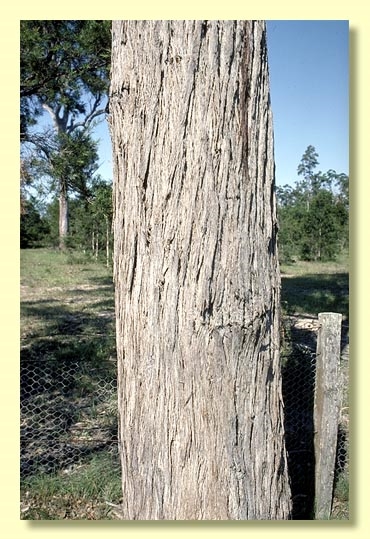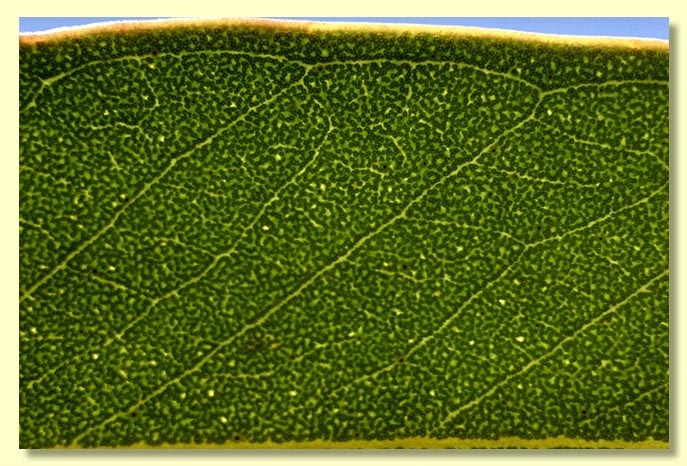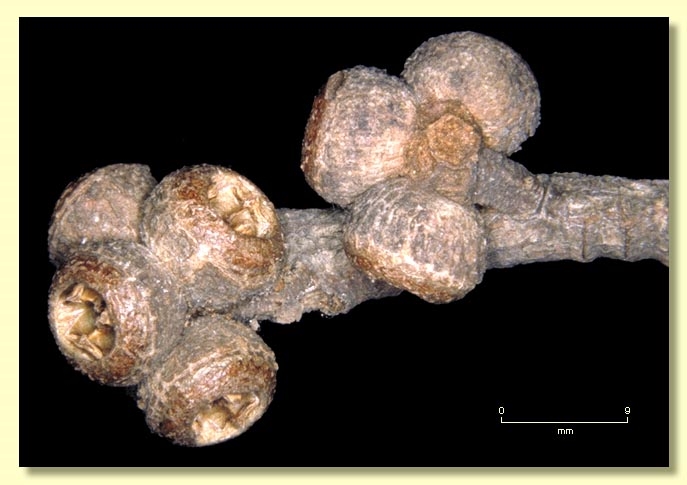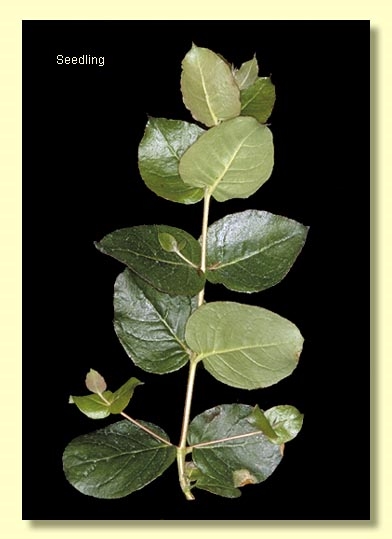Euclid - Online edition
Eucalyptus camfieldii
Eucalyptus | Eucalyptus | Capillulus | Pachyphloius
T: Middle Harbour, Sydney, NSW, 25 May 1897, J.H.Camfield s.n.; holo: NSW.
Bark rough, coarsely fissured and stringy to small branches, grey or grey-brown.
Juvenile growth (coppice or field seedlings to 50 cm): stem rounded in cross-section, scabrid but becoming smooth higher up; lowest leaves opposite but soon alternate, shortly petiolate (petioles 0–0.4 cm), orbicular or cordate, sometimes elliptical, and always mucronate, 1.5-5.3 cm long and 1-4 cm wide, base lobed to rounded or oblique, or amplexicaul at lower nodes, margin undulate and irregular with conspicuous hairs, apex pointed or rounded, lamina becoming thicker up the stem, smooth and glossy mid-green on upper side, paler green and scabrid hairy below especially at lower nodes.
Adult leaves alternate, petiole 1–2.5 cm long; blade broadly lanceolate, less commonly ovate, 6–11 cm long, 1.8–4 cm wide, base oblique, thick-textured, concolorous, glossy, green, side-veins at an acute or wider angle to midrib, obscurely to sparsely reticulate, intramarginal vein parallel to and well removed from margin, oil glands obscure.
Inflorescence axillary unbranched, peduncle thick, stout or broadly flattened, 0.5–1 cm long, buds 9 to15 per umbel, sessile or to 0.1 cm. Mature buds ovoid to oblong, 0.6–1 cm long, 0.3-0.4 cm wide, smooth, still angled longitudinally at flowering, scar absent, operculum usually conical but more rounded when buds mature, rarely rounded, stamens irregularly flexed, anthers reniform to cordate, versatile, dorsifixed, dehiscing by confluent slits, style long, stigma tapered, locules 3 or 4, the placentae each with 2 vertical ovule rows in each locule. Flowers white.
Fruit sessile, flattened-hemispherical, 0.4–0.5 cm long, (0.6)0.7–0.9(1.1) cm wide, crowded but not laterally compressed, disc raised-convex or oblique, valves 3 or 4, near rim level.
Seeds dark brown, 1.5–2.3 mm long, pyramidal or obliquely pyramidal, dorsal surface smooth, hilum terminal.
Cultivated seedlings (measured at ca node 10): cotyledons reniform; stems rounded in cross-section, stellate-hairy; leaves shortly petiolate, opposite until node 6 to 10 then alternate, broadly ovate to oblong or almost orbicular, 5–8 cm long, 4–6 cm wide, base rounded to truncate or lobed, margin irregular to undulate, apex pointed, discolorous, mid-green and glossy above, paler beneath. Stems and leaves scabrid with stellate hairs to at least node 10.
Flowering has been recorded in February, March, June, August, September, October, November and December.
A rare stringybark mallee or stunted tree endemic to New South Wales, of restricted distribution south from Port Stephens to Sydney, Royal National Park and Bulli Pass. Always on poor shallow sandy soils on sandstone ridges and some headlands as a component of tall closed heath. Eucalyptus camfieldii is distinguished from other stringybarks by its stunted form, short and broad thick-textured green adult leaves with broad petioles, more or less orbicular seedling and juvenile leaves with lobed to oblique bases and prominent mucronate apex, slightly angular buds and tightly clustered sessile fruits wider than long (0.7–0.9 cm wide, rarely to 1.1 cm).
Within the natural range of E. camfieldii there are some ten other species of stringybarked eucalypt and none has the more or less orbicular seedling and juvenile leaves of this species. Two of these other stringybark species, however, have sessile fruit of similar shape and size to those of E. camfieldii and similarly clustered together: E. capitellata, which has more prominently petiolate ovate-lanceolate juvenile leaves with tapering leaf base; and E. agglomerata, which also has larger distinctly petiolate ovate juvenile leaves with tapering leaf bases, thinner textured adult leaves more blue-green in colour and fusiform buds. Both of these species may occur as stunted trees on poorer sites but are more usually well-formed woodland or forest trees.
E. camfieldii is considered closely related to E. bensonii, the latter a species endemic to the Wollemi country south-east of Rylstone, New South Wales. E. bensonii differs in having buds with a more conical operculum, ovate juvenile leaves that have rounded, not cordate, bases, and a more stunted often mallee habit.
Eucalyptus camfieldii is listed as "Vulnerable" under the Australian Government Environment Protection and Biodiversity Conservation Act 1999 (EPBC Act). Further information may be found at this web address:
http://www.environment.gov.au/cgi-bin/sprat/public/sprat.pl













